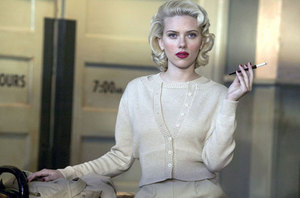September 25, 2006
Aguilera versus De Palma
 |  |
I'm the world's greatest apologist for Brian De Palma but his version of Elroy's The Black Dahlia is a disaster. The plot is so incomprehensible that you are left wondering how the director thought anyone would be able to follow it (one exasperated reviewer said that he'd read the novel twice and even he didn't know what was going on). Worse, the film pursues a hackneyed Stylishness, as embodied in Scarlett Johansson's horribly stilted performance - Am Dram mannequin in dressing up box outfits, ostentatiously twirling a cigarette holder because That's What Screen Vamps Do.
De Palma is peculiarly unsuited to adapt Elroy. His stock-in-trade is the lurid and the excessive, not rapid-fire realism. 'Noir' has been talked about a great deal in the discussion of The Black Dahlia, but De Palma's palllete couldn't be less monochrome; it's the very definition of garish. His preferred mode is oneiric, and his best films, with their weird transitions between honeyed sentimentalism and appalling cruelty, have the languid tension and sudden violence of a de Chirico canvas. They are rightly considered sick, and the glimpse they give us of the patho-logic of fantasy is their great virtue.
De Palma's great theme, obsessively reiterated, is betrayal. But the trick that he pulled in every film from Obsession through to Carlito's Way and Mission Impossible - exposing a trusted character as a betrayer - is immediately undercut in The Black Dahlia because we don't even for a moment entertain the thought that any of the characters is anything other than deeply corrupt. The problem with these Elroy adaptations - and this is no slur on Elroy, whom I must confess I haven't read - is that universal corruption is now practically a period detail, as standard a feature as muted trumpet on the soundtrack.
There are, naturally, moments of vulgar sublime brilliance, when De Palma's creepy grotesquerie breaks the bounds of ultra-realism, and we start to feel uncomfortable (discomfort is actually the feeling that De Palma at his most effective elicits, a discomfort that arises in part from his incapacity or unwillingness to temper his excesses and make a 'Good' film ... Often, we find ourselves asking, should we be watching this?, as if sensing that too much unconscious material has been revealed).
Owen observed after seeing The Black Dahlia that one of the most interesting aspects of the film was its unresolved handling of the period setting; at times it felt like an updating of the 40s using the techniques of the 21st century, at others the 21st century as seen through the lenses of the 1940s. A similar sense of dyschronia dominates Christina Aguilera's new album, Back to Basics. Hearing that the album was 'inspired by soul, jazz and blues of the '20s, '30s and '40s' made you expect the worst: the necrotic hand of Authenticity, all the Jools Holland horrors.... The fabulously hectic single 'Ain't No Other Man' put those pre-conceptions to flight. Aguilera's choice of the nearly forgotten Premier as producer showed excellent judgement; the 'Picasso of hip-hop' didn't slavishly re-construct a Period Sound so much as as he cubistically de-constructed it. The great service that hip hop can still perform for pop is to remind us of its essential lack of presence. One of the paradoxes of postmodern culture, of course, is that it is always forced to return to - an illusory, supposedly pre-mediated - past in its pursuit of real, live presence. Reading interviews with Aguilera, and listening to the roll-call of inspirations on the album itself - which include Minnie Ripperton, Marvin Gaye and Aretha Franklin - it is clear that the Past being summoned here has nothing to do with a specific historical period, even one as broadly-defined as 'the 20s, 30s and 40s'. What is being reached for is a prelapsarian Lost Present, the past as such. On the tracks he produces on Back to Basics, Premier shows us that this Past is only available to us through filters and screens, foregrounding the dyschronia via the famously angular quality of his samples and the inclusion of scratched vinyl noise. That is why 'Ain't No Other Man' sounds more like steampunk 2-step than an accurate simulation of a historical moment.
It is perhaps the cartoonish setting of 'Ain't No Other Man' that makes Aguilera's voice more bearable than normal. It is hard to think of a voice less Soul-ful than Aguilera's; its honking, stentorian force, so inhumanly invulnerable, is even less suited for the expression of emotions than the efficient gymnastic displays of Carey or Dion. The discrepancy between the impersonal force of Aguilera's voice and the ultra-personal nature of some of the songs (fuck yous to her former producer, accounts of domestic abuse in her family, paeans to her new husband) makes listening to Back to Basics an oddly disconcerting experience at times.
There is nothing on the album to match 'Ain't No Other Man'. But Back to Basics is always interesting, if only as a symptom of a chronic malaise. The second disc, produced by Linda Perry, was supposedly envisaged as a more authentic Jazz Age simulation. Thankfully, however, the anachronisms are not entirely purged, and some tracks - the soft-focus, sepia-smeared Jessica Rabbit torch song, 'Trouble' and the next single, 'Candyman', a lewd hijacking of 'Boogie Woogie Bugle Boy'- are not without charm.
A few years ago, an exercise in anachronism like Back to Basics might have seemed paradigmatically postmodern. But that was before revivalism became so naturalized that the question of historicity was suspended altogether.
Posted by mark at September 25, 2006 11:05 AM | TrackBack